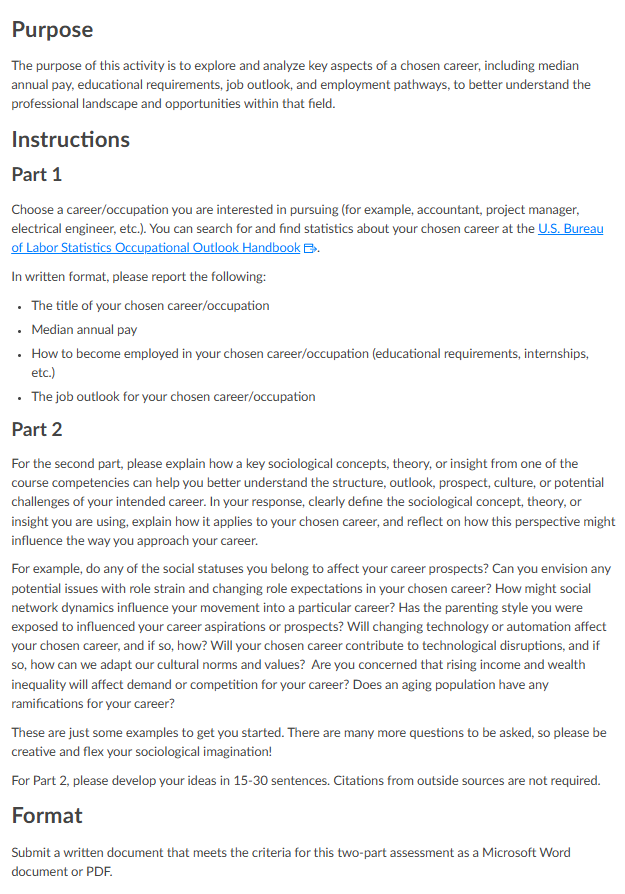Applying Sociology to Real-World Career Goals
Overview
Students choose a career they’re interested in and apply sociological concepts to examine how social forces may affect their access to and success within that profession.
Why Use This?
This activity helps students apply sociological concepts in a way that is relevant and personal. By connecting these concepts to their career goals, students begin to see how larger social issues, like wealth inequality and rapidly changing technology or automation, can influence their future job prospects and work experiences.
How Does It Work?
Students begin by selecting a career they’re interested in and researching it using the U.S. Bureau of Labor Statistics’ Occupational Outlook Handbook. They gather important details like median annual pay, required education or training, and job outlook.
After researching their chosen career, students select a sociological concept, theory, or insight from the course and explain how it relates to that profession. For example, they might examine how the parenting style they experienced influences their career aspirations or how access to social or professional networks affects hiring and advancement in their chosen field.
Finally, students submit their work as a two-part written assignment: career research and sociological analysis.

Purpose
The purpose of this activity is to explore and analyze key aspects of a chosen career, including median annual pay, educational requirements, job outlook, and employment pathways, to better understand the professional landscape and opportunities within that field.
Shape
Instructions
Part 1
Choose a career/occupation you are interested in pursuing (for example, accountant, project manager, electrical engineer, etc.). You can search for and find statistics about your chosen career at the U.S. Bureau of Labor Statistics Occupational Outlook Handbook.
In written format, please report the following:
The title of your chosen career/occupation
Median annual pay
How to become employed in your chosen career/occupation (educational requirements, internships, etc.)
The job outlook for your chosen career/occupation
Shape
Part 2
For the second part, please explain how a key sociological concept, theory, or insight from one of the course competencies can help you better understand the structure, outlook, prospect, culture, or potential challenges of your intended career. In your response, clearly define the sociological concept, theory, or insight you are using, explain how it applies to your chosen career, and reflect on how this perspective might influence the way you approach your career.
For example, do any of the social statuses you belong to affect your career prospects? Can you envision any potential issues with role strain and changing role expectations in your chosen career? How might social network dynamics influence your movement into a particular career? Has the parenting style you were exposed to influenced your career aspirations or prospects? Will changing technology or automation affect your chosen career, and if so, how? Will your chosen career contribute to technological disruptions, and if so, how can we adapt our cultural norms and values? Are you concerned that rising income and wealth inequality will affect demand or competition for your career? Does an aging population have any ramifications for your career?
These are just some examples to get you started. There are many more questions to be asked, so please be creative and flex your sociological imagination!
For Part 2, please develop your ideas in 15–30 sentences. Citations from outside sources are not required.
Shape
Format
Submit a written document that meets the criteria for this two-part assessment as a Microsoft Word document or PDF.
Keep In Mind
- You might adapt this example into a small group activity, where students share and discuss their findings with their peers instead of submitting individual papers.
- If students struggle with the analysis part of the assignment, consider providing an example using your own (or a fictional) career path to show how sociological thinking can be applied.
- You might consider adding a reflection component that asks students if the activity influenced their thoughts about their career path in any way (whether positively or negatively).